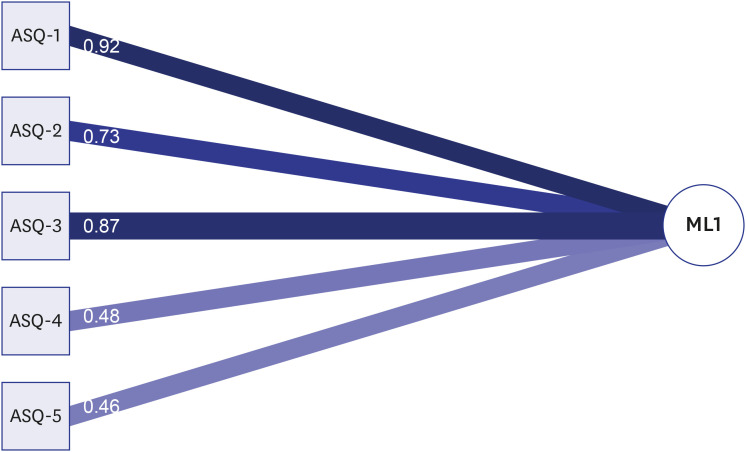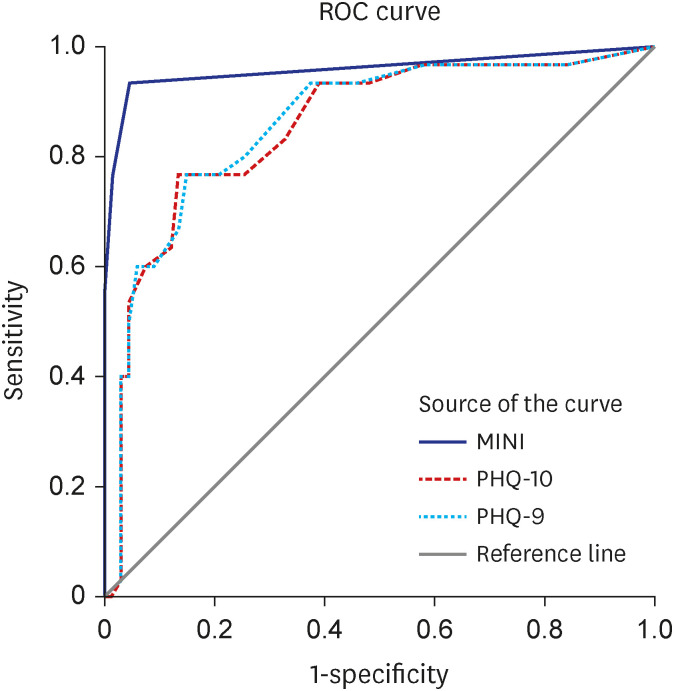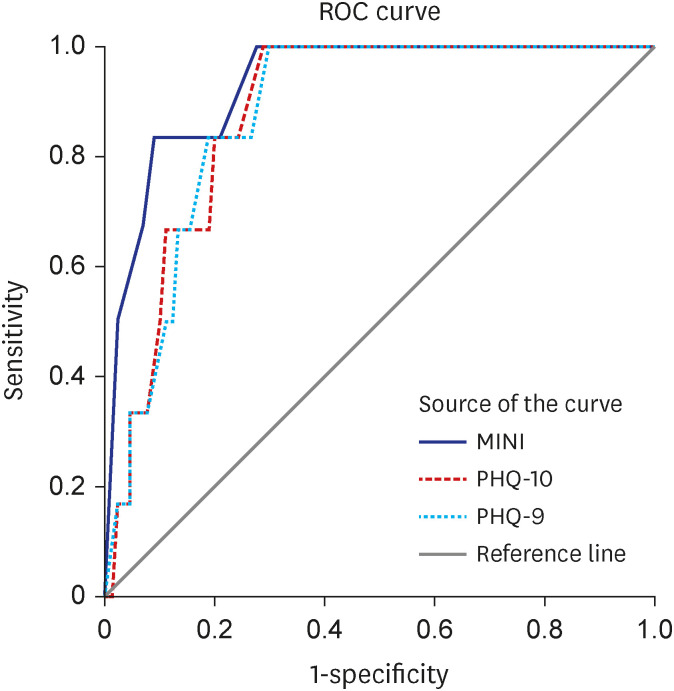J Korean Med Sci.
2023 Feb;38(6):e41. 10.3346/jkms.2023.38.e41.
Reliability and Validity of the Korean Version of the Ask Suicide-Screening Questions (ASQ)
- Affiliations
-
- 1School of Nursing, Hanyang University, Seoul, Korea
- 2Department of Psychiatry, College of Medicine, Hanyang University, Seoul, Korea
- 3Department of Nursing, Hanyang University Medical Center, Seoul, Korea
- KMID: 2539490
- DOI: http://doi.org/10.3346/jkms.2023.38.e41
Abstract
- Background
The Ask Suicide-Screening Questions (ASQ) tool is a simple suicide screening tool developed to screen patient suicide risk (SR). The purpose of this study was to verify the reliability and validity of the ASQ tool in hospitalized patients.
Methods
The internal consistency and test-retest reliability of the South Korean version of the ASQ tool were verified in 99 hospitalized patients admitted to a tertiary medical institution in Seoul. To verify the correlations and validity of each convergence with other scales, the Mini-International Neuropsychiatric Interview (MINI), Patient Health Questionnaire-9 (PHQ-9), Generalized Anxiety Disorder-7 (GAD-7), and Satisfaction with Life Scale (SWLS) were also conducted to determine convergent and discriminant validity. Then, the receiver operating characteristic (ROC) curve diagnosis values for suicide and depression levels with the highest correlations were analyzed.
Results
As a result, Cronbach’s alpha was 0.826, and when each item was removed sequentially, Cronbach’s alpha ranged from 0.736–0.840, showing stable internal consistency. Most of the corrected item-total correlation were over 0.500; however, a relatively low correlation was shown for the fourth and fifth questions, which had values of 0.429 and 0.410, respectively. The test-retest reliability was 0.830, and the MINI and PHQ-9 showed high values of 0.872 and 0.672, respectively. The area under the curve (AUC) according to the ASQ diagnosis value was also the highest for the MINI (0.936).
Conclusion
The validity and reliability of the South Korean version of the ASQ tool were demonstrated. Through this validation, the ASQ tool can be used for simple suicide risk screening (SRS) in hospitalized patients.
Keyword
Figure
Reference
-
1. Statistics Korea. Cause of Death. Daejeon, Korea: Statistics Korea;2020.2. Sher L. The impact of the COVID-19 pandemic on suicide rates. QJM. 2020; 113(10):707–712. PMID: 32539153.
Article3. Cavanagh JT, Carson AJ, Sharpe M, Lawrie SM. Psychological autopsy studies of suicide: a systematic review. Psychol Med. 2003; 33(3):395–405. PMID: 12701661.
Article4. Lee JI, Lee MB, Liao SC, Chang CM, Sung SC, Chiang HC, et al. Prevalence of suicidal ideation and associated risk factors in the general population. J Formos Med Assoc. 2010; 109(2):138–147. PMID: 20206838.
Article5. Roth KB, Borges G, Medina-Mora ME, Orozco R, Ouéda C, Wilcox HC. Depressed mood and antisocial behavior problems as correlates for suicide-related behaviors in Mexico. J Psychiatr Res. 2011; 45(5):596–602. PMID: 21055767.
Article6. Tishler CL, Reiss NS. Inpatient suicide: preventing a common sentinel event. Gen Hosp Psychiatry. 2009; 31(2):103–109. PMID: 19269529.
Article7. Bentley KH, Franklin JC, Ribeiro JD, Kleiman EM, Fox KR, Nock MK. Anxiety and its disorders as risk factors for suicidal thoughts and behaviors: a meta-analytic review. Clin Psychol Rev. 2016; 43:30–46. PMID: 26688478.
Article8. Jae JM. Suicide and psychiatric disorder. J Korean Soc Biol Ther Psychiatry. 2004; 10(1):3–10.9. Kumar G, Steer RA. Psychosocial correlates of suicidal ideation in adolescent psychiatric inpatients. Suicide Life Threat Behav. 1995; 25(3):339–346. PMID: 8553414.10. Runeson BS, Beskow J, Waern M. The suicidal process in suicides among young people. Acta Psychiatr Scand. 1996; 93(1):35–42. PMID: 8919327.
Article11. Cooper J, Kapur N, Webb R, Lawlor M, Guthrie E, Mackway-Jones K, et al. Suicide after deliberate self-harm: a 4-year cohort study. Am J Psychiatry. 2005; 162(2):297–303. PMID: 15677594.
Article12. Walsh CG, Ribeiro JD, Franklin JC. Predicting risk of suicide attempts over time through machine learning. Clin Psychol Sci. 2017; 5(3):457–469.
Article13. Luby JL, Belden AC, Jackson JJ, Lessov-Schlaggar CN, Harms MP, Tillman R, et al. Early childhood depression and alterations in the trajectory of gray matter maturation in middle childhood and early adolescence. JAMA Psychiatry. 2016; 73(1):31–38. PMID: 26676835.
Article14. Davidson L, Linnoila M. Risk Factors for Youth Suicide. New York, NY, USA: Taylor & Francis;2013.15. Posner K, Brown GK, Stanley B, Brent DA, Yershova KV, Oquendo MA, et al. The Columbia-Suicide Severity Rating Scale: initial validity and internal consistency findings from three multisite studies with adolescents and adults. Am J Psychiatry. 2011; 168(12):1266–1277. PMID: 22193671.
Article16. Kroenke K, Spitzer RL, Williams JB. The PHQ-9: validity of a brief depression severity measure. J Gen Intern Med. 2001; 16(9):606–613. PMID: 11556941.17. Boudreaux ED, Jaques ML, Brady KM, Matson A, Allen MH. The patient safety screener: validation of a brief suicide risk screener for emergency department settings. Arch Suicide Res. 2015; 19(2):151–160. PMID: 25826715.
Article18. Reynolds WM. Suicidal Ideation Questionnaire (SIQ). Odessa, FL, USA: Psychological Assessment Resources;1987.19. Aguinaldo LD, Sullivant S, Lanzillo EC, Ross A, He JP, Bradley-Ewing A, et al. Validation of the ask suicide-screening questions (ASQ) with youth in outpatient specialty and primary care clinics. Gen Hosp Psychiatry. 2021; 68:52–58. PMID: 33310014.
Article20. Kemper AR, Hostutler CA, Beck K, Fontanella CA, Bridge JA. Depression and suicide-risk screening results in pediatric primary care. Pediatrics. 2021; 148(1):e2021049999. PMID: 34099503.
Article21. Inman DD, Matthews J, Butcher L, Swartz C, Meadows AL. Identifying the risk of suicide among adolescents admitted to a children’s hospital using the Ask Suicide-Screening Questions. J Child Adolesc Psychiatr Nurs. 2019; 32(2):68–72. PMID: 31025489.
Article22. Horowitz LM, Bridge JA, Teach SJ, Ballard E, Klima J, Rosenstein DL, et al. Ask Suicide-Screening Questions (ASQ): a brief instrument for the pediatric emergency department. Arch Pediatr Adolesc Med. 2012; 166(12):1170–1176. PMID: 23027429.23. DeVylder JE, Ryan TC, Cwik M, Wilson ME, Jay S, Nestadt PS, et al. Assessment of selective and universal screening for suicide risk in a pediatric emergency department. JAMA Netw Open. 2019; 2(10):e1914070. PMID: 31651971.
Article24. Ballard ED, Cwik M, Van Eck K, Goldstein M, Alfes C, Wilson ME, et al. Identification of at-risk youth by suicide screening in a pediatric emergency department. Prev Sci. 2017; 18(2):174–182. PMID: 27678381.
Article25. Lanzillo EC, Horowitz LM, Wharff EA, Sheftall AH, Pao M, Bridge JA. The importance of screening preteens for suicide risk in the emergency department. Hosp Pediatr. 2019; 9(4):305–307. PMID: 30858170.
Article26. Mills PD, DeRosier JM, Ballot BA, Shepherd M, Bagian JP. Inpatient suicide and suicide attempts in Veterans Affairs hospitals. Jt Comm J Qual Patient Saf. 2008; 34(8):482–488. PMID: 18714751.
Article27. Combs H, Romm S. Psychiatric inpatient suicide: a literature review. Prim Psychiatry. 2007; 14(12):67–74.28. Osman A, Bagge CL, Gutierrez PM, Konick LC, Kopper BA, Barrios FX. The Suicidal Behaviors Questionnaire-Revised (SBQ-R): validation with clinical and nonclinical samples. Assessment. 2001; 8(4):443–454. PMID: 11785588.
Article29. Park SJ, Choi HR, Choi JH, Kim KW, Hong JP. Reliability and validity of the Korean version of the Patient Health Questionnaire-9 (PHQ-9). Anxiety Mood. 2010; 6(2):119–124.30. Spitzer RL, Kroenke K, Williams JB, Löwe B. A brief measure for assessing generalized anxiety disorder: the GAD-7. Arch Intern Med. 2006; 166(10):1092–1097. PMID: 16717171.
Article31. Lee SH, Shin C, Kim H, Jeon SW, Yoon HK, Ko YH, et al. Validation of the Korean version of the generalized anxiety disorder 7 self-rating scale. Asia-Pac Psychiatry. 2022; 14(1):e12421. PMID: 32893471.
Article32. Pavot W, Diener E. The satisfaction with life scale and the emerging construct of life satisfaction. J Posit Psychol. 2008; 3(2):137–152.
Article33. Lim YJ. Psychometric properties of the satisfaction with life scale among Korean police officers, university students, and adolescents. Korean J Psychol Gen. 2012; 31(3):877–896.34. Yoo SW, Kim YS, Noh JS, Oh KS, Kim CH, Namkoong K, et al. Validity of Korean version of the mini-international neuropsychiatric interview. Anxiety Mood. 2006; 2(1):50–55.35. Canan F, Ataoglu A, Nichols LA, Yildirim T, Ozturk O. Evaluation of psychometric properties of the internet addiction scale in a sample of Turkish high school students. Cyberpsychol Behav Soc Netw. 2010; 13(3):317–320. PMID: 20557252.
Article36. Khazaal Y, Billieux J, Thorens G, Khan R, Louati Y, Scarlatti E, et al. French validation of the internet addiction test. Cyberpsychol Behav. 2008; 11(6):703–706. PMID: 18954279.
Article37. Horowitz LM, Snyder DJ, Boudreaux ED, He JP, Harrington CJ, Cai J, et al. Validation of the ask suicide-screening questions for adult medical inpatients: a brief tool for all ages. Psychosomatics. 2020; 61(6):713–722. PMID: 32487323.
Article38. Pecache DR, Nancho RM, Cuisia-Cruz ES. 124. Validation of the Ask Suicide-Screening Questions (ASQ) as a suicide screening tool for adolescents in the outpatient population of a tertiary hospital. J Adolesc Health. 2022; 70(4):S66.
Article39. Thom R, Hogan C, Hazen E. Suicide risk screening in the hospital setting: a review of brief validated tools. Psychosomatics. 2020; 61(1):1–7. PMID: 31629482.
Article40. Chang BP, Tan TM. Suicide screening tools and their association with near-term adverse events in the ED. Am J Emerg Med. 2015; 33(11):1680–1683. PMID: 26346049.
Article41. Christensen LeCloux M, Aguinaldo LD, Lanzillo EC, Horowitz LM. Provider opinions of the acceptability of Ask Suicide-Screening Questions (ASQ) Tool and the ASQ Brief Suicide Safety Assessment (BSSA) for universal suicide risk screening in community healthcare: Potential barriers and necessary elements for future implementation. J Behav Health Serv Res. 2022; 49(3):346–363. PMID: 35266079.
Article
- Full Text Links
- Actions
-
Cited
- CITED
-
- Close
- Share
- Similar articles
-
- Validity and Reliability of the Korean Version of Advance Directives Attitude Scale for Nurses
- A Comparison of the Korean-Ages and Stages Questionnaires and Denver Developmental Delay Screening Test
- A Study of the Reliability and Validity of the Korean Version of the Reasons for Living Inventory for Adolescents
- The Reliability and Validity of the Korean Version of Columbia-Suicide Severity Rating Scale in Alcohol Dependent Patients
- Reliability and Validity of Short Form, Parental Version of the Korean Swanson, Nolan and Pelham-IV (SNAP-IV)




